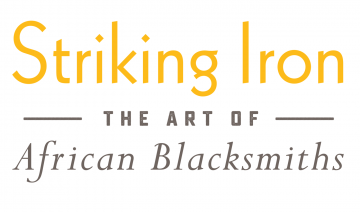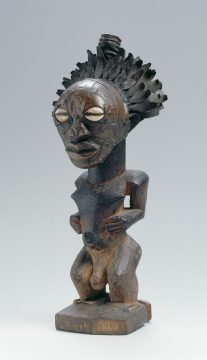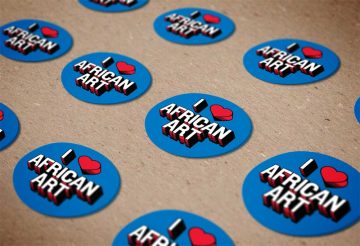 In Africa south of the Sahara, iron figures prominently as a medium that activates spiritual power. The blacksmith—as master of the transformative processes of making iron into culture’s tools, weapons, and poetic accoutrements—is often charged with making the very objects used to invoke, represent, and mediate deities and other mediums of supernatural agency. He is called upon to enhance humanity’s ability to survive and thrive.
In Africa south of the Sahara, iron figures prominently as a medium that activates spiritual power. The blacksmith—as master of the transformative processes of making iron into culture’s tools, weapons, and poetic accoutrements—is often charged with making the very objects used to invoke, represent, and mediate deities and other mediums of supernatural agency. He is called upon to enhance humanity’s ability to survive and thrive.
In this section, a series of case studies illustrate the diverse ways that iron and the skills of the blacksmith are brought together in the arts of Africa. Think about how iron:
- links to deities, spiritual beings, and culture heroes;
- demonstrates exceptional skill and specialized knowledge;
- embellishes the body and recognizes status, authority, and social transformations; and
- activates potent forces that make things happen.
Yorùbá, Edo, and Fon | Iron’s Performative Power

Democratic Republic of the Congo
Power figure (nkisi nkondi)
18th to 19th century
Wood, iron, copper alloy, mirror, cloth, cordage, glass beads, cowrie shells (Cypraea moneta)
Fowler Museum at UCLA, X65.5837, gift of the Wellcome Trust
Well-armed. This power figure (nkisi nkondi) acts as an armature for a large array of materials added by a healer who alone knew the secret composition of herbal medicines, roots, plants, and even small carved wood sculptures that gave the object its efficacy. Staring eyes chipped from mirrors warned aggressors and deflected their malice, while potent substances held in a bundle over the navel were hidden from view by the cape of cloth strips. The insertion of each piece of iron awakened and directed supernatural agencies to human desires and needs.
Fon Altars for Honoring the Dead | Asen
Exquisite praise. Fon commission blacksmiths to produce umbrella-shaped asen staffs, kept in shrines to celebrate ancestors and the Fon pantheon. Asen are surmounted by circular platforms richly decorated with human figures, animals, plants, and other details of everyday life. They bestow honor on ancestors as material realizations of praise-poems, and are enhanced by blacksmiths’ consummate skill in forging the miniature figurative elements of these “memoryscapes.” Some asen feature tiers of hanging rattles that make gentle sounds in the breeze, attracting ancestors’ positive intervention.
Objects of Force and Fury | Bociọ
Power visualized. Ògún’s iron finds its warrior role again in bociọ. These power objects are assembled of seen and unseen materials to protect people and attack enemies both known and otherworldly. In addition to iron, a bociọ might involve wood, bones, straw, leather, pottery, cloth, fur, feathers, blood, and beads, as well as libations, prayers, curses, songs, and activating gestures. Containing many secrets, such objects are meant to provoke deep, visceral emotion. If knowledge of its makeup were to spread, its potency could be compromised or even negated.

Democratic Republic of the Congo
Power figure (nkishi)
Mid- to late 19th century
Wood, iron, copper alloy, cowrie shell (Cypraea moneta), horn
Field collected in 1920 by Louis Franck (1868–1937)
Collection of the MAS, Antwerp, Belgium (AE.0720), gift of Louis Franck, Antwerp, 1920
This nkishi, selected for the Belgian Pavilion at the 1939 New York World’s Fair, was nicknamed “the man with iron hair.” Its headdress is composed of forged curved blades resembling those of a tree pangolin, a heavily scaled forest animal that rolls into a ball to make itself impervious (even to a leopard’s bite). Here, iron scales protect a community, especially the head as the font of wisdom.
Kongo and Songye | Iron as Activator
Visualizing power. Sculptures called nkisi by the Kongo and nkishi by the Songye belong to relationships and practices that defend communities against misfortune. The objects rely on the presence of iron to activate their potencies, promote community interests, and warn of the perilous powers unleashed against individuals who attack or otherwise compromise community welfare.
Kongo are clusters of peoples living around the mouth of the Congo River in present-day Democratic Republic of the Congo (DRC). Historically, their complex states drew trade from many directions (including, as of the 1940s, Europe). Songye peoples live in forested areas of east-central DRC, and, like Kongo, have developed exceptionally rich visual and performance arts.
Luba | Forging Kings
Divine iron. Control of iron ore deposits, efficient smelting methods, and trade in iron implements were strategically important to the rise of certain central African states. In present-day Democratic Republic of the Congo, Luba peoples revere divine kings who are “forged” through processes that removed them from ordinary human definitions and assured their impartiality. Origin stories explain the mythological and political significance of these “blacksmith-kings” descended from the great culture hero Mbidi Kiluwe, who introduced ironworking technologies to forever change Luba political economies and fortunes.

Karagwe District, Kagera Region, Tanzania
Photograph by Israel K. Katoke, mid-20th century
Courtesy the Katoke Estate, Dar es Salam, Tanzania, 2018
Karagwe Blacksmith Kings
Iron treasures. Karagwe peoples of northeastern Tanzania live in an area with some of the earliest known iron smelting sites in eastern Africa. King Ndagara, who reigned from the 1820s until 1853, was himself a masterful blacksmith. He is reputed to have forged a large treasury of iron standards, weapons, anvils, and sculptures of cattle. Among them, sinuously forged rods plaited together appear as supple as intertwining vines, with sockets at their upper ends to hold branches of omusinga (Hibiscus fuscus), a tall, flowering shrub with medicinal and practical applications. The bovine figures include two versions with exaggerated curved horns, sweeping upward in one example and downward in the other. Karagwe understood these virile figures to be divine leaders of the herds that defined the king’s wealth.
